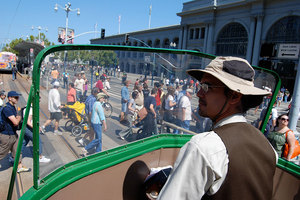In What Have We Learned? we discussed what we have learned since the first Trolley Festival 25 years ago about the pluses and minuses of various vintage streetcar types in F-line service. Now, we discuss what we’ve learned about operations over that period.

Looking back at the first Trolley Festival, it’s easy to forget how much the streetcars’ surroundings have changed in the last quarter-century. After all, Market Street is still Market Street. But automobile traffic on our main drag has gotten far heavier. So has the ridership on the cars themselves. And of course the F-line itself is twice as long as in Trolley Festival days. Have F-line operations adapted to these changes?
Not so much. Despite sporadic efforts by Muni to improve service in the past, longtime bottlenecks remain, delaying service and contributing to bunching. Market Street Railway and the current leadership of Muni have had productive discussions on how to make things better. The problems — and solutions — fall into a few specific categories.
It makes more sense to extend the carpool lane to at least Fremont Street, so Market Street won’t be backed up.
And if the 9 were reassigned to the curb, it would probably have to end at Transbay Terminal, which is being temporarily relocated anyway.
I know the Embarcadero Shuttles have schedules, but i still do not understand why some “on the fly adjustments” can’t be made when there is a supervisor down there…Why can’t they have “run as directed” runs (or however you call them) where a supervisor can see a crowd at the Ferry building…send a shuttle on a run and if it’s way off schedule, have them turn at Pier 39??
Maybe I’ve told this story before–one weekend afternoon, I was waiting for a “J” car at Embarcadero, and waiting, and waiting. Some others on the platform also wanted to “go to Church”, and after seeing every other letter of the Muni alphabet a few times, I finally decided to get the attention of the supervisor (not sure if I was wearing my MSRy cap at the time). I told him about the situation, and when the next car came in he told the operator “You’re a ‘J'”. The operator changed his headsign and we were off and running. So they can make adjustments–it may depend on the supervisor.
I don’t think you did, not on this blog, Bob.
Yeah, all the routes lie on the supervisor, I think they need operators who are assigned to Board runs in order for the changes to take place
For solving some of the overcrowding problems on the F
line, I am always surprised that possibility of getting
some higher capacity cars has not been considered. Some
double-ended, 8-axle German or Austrian streetcars, for example, would carry a lot more passengers and could be used on the “E” line. If we ever get proof of payment, if would be possible to run units in multiple for even higher capacity. It’s clear that the E-line is going to have high peak ridership on occasions like the end of a game at AT&T park.
The “Embarcadero Shuttles” should NOT have any schedule and they should turn around, at the short loop, at Pier 39. When a shuttle operator sees a large crowd at the Ferry Building stop, and no F line cars coming down Market Street, he should start his run and pick up that crowd. After dropping off the passengers at Pier 39, take the short turn loop, stop and tell the passengers waiting across the street, that he is departing for the ferry building as soon as possible. He would then take that load off the next F line car and pick up more people on the Embarcadero. Run as many “Shuttles” as possible!!
Proof of payment. No cars on market street. The new E line. Timed traffic signals. A $1 surcharge for cash paying customers used to refurbish and run more historic street cars. Put together these ideas can really make a difference. If there are still packed cars, but more total passengers, that’s great. These efficient measure, such as congestion pricing (the $1 surcharge), would also ensure people using the service value it more.
What about, god forbid, running the Breda Light rail veicles on Market Street? Retrofit the trolley wires on Market Street so that it’s not a shared trolley bus/streetcar trolleywire confuration like it is now (they should be separate anyway)and either run some LRVs or purchase some Portland Oregon type streetcars to supplement the historic streetcars on Market Street. Auto traffic should be at least partially restricted on weekends and off peak hours to expedite Muni Traffic. Priority signaling is a must. Proof of Payment is also a must.
Actually, it would be easier to just put trolley poles on the Breda trains. Retrofitting the wires on Market Street would be disruptive, time consuming, might be too much of a power drain for how it’s set up now and wouldn’t buy you much for the cost of all that work. When the time does come to rewire market, it pantograph compatibility is something to consider.
Though it’s not like there are spare Breda sitting around. Muni is already in the margins of how many can put into service (about 120-125 out of 151, 4 of which have body damage or are not operable, so 147 really) while the rest are down for maintenance. MTA is starting to look at ordering up to 20 more vehicles to keep up with demand and I think modern low floor surface service would be a good option (and they’d contrast and compliment the historic streetcars) so we can start transitioning away from high-floor LRVs. I think the J-Line makes a good candidate for low-floor streetcars since it doesn’t have any elevated platforms outside the subway and would open up more capacity in the tunnel for higher ridership (the F has more riders than the J) lines.